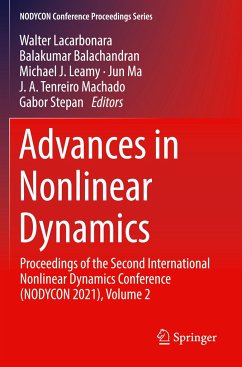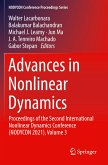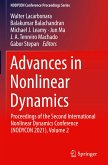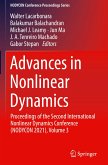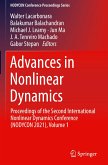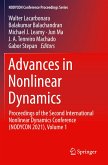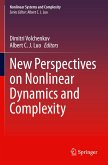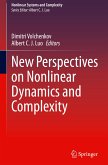Advances in Nonlinear Dynamics
Proceedings of the Second International Nonlinear Dynamics Conference (NODYCON 2021), Volume 2
Herausgegeben:Lacarbonara, Walter; Balachandran, Balakumar; Leamy, Michael J.; Ma, Jun; Tenreiro Machado, J. A.; Stepan, Gabor
Advances in Nonlinear Dynamics
Proceedings of the Second International Nonlinear Dynamics Conference (NODYCON 2021), Volume 2
Herausgegeben:Lacarbonara, Walter; Balachandran, Balakumar; Leamy, Michael J.; Ma, Jun; Tenreiro Machado, J. A.; Stepan, Gabor
- Broschiertes Buch
- Merkliste
- Auf die Merkliste
- Bewerten Bewerten
- Teilen
- Produkt teilen
- Produkterinnerung
- Produkterinnerung
This second of three volumes includes papers from the second series of NODYCON which was held virtually in February of 2021. The conference papers reflect a broad coverage of topics in nonlinear dynamics, ranging from traditional topics from established streams of research to those from relatively unexplored and emerging venues of research. These include
· Nonlinear vibration control
· Control of nonlinear systems and synchronization
· Experimental dynamics
· System identification and SHM
· Multibody dynamics
Andere Kunden interessierten sich auch für
![Advances in Nonlinear Dynamics Advances in Nonlinear Dynamics]() Advances in Nonlinear Dynamics231,99 €
Advances in Nonlinear Dynamics231,99 €![Advances in Nonlinear Dynamics Advances in Nonlinear Dynamics]() Advances in Nonlinear Dynamics231,99 €
Advances in Nonlinear Dynamics231,99 €![Advances in Nonlinear Dynamics Advances in Nonlinear Dynamics]() Advances in Nonlinear Dynamics231,99 €
Advances in Nonlinear Dynamics231,99 €![Advances in Nonlinear Dynamics Advances in Nonlinear Dynamics]() Advances in Nonlinear Dynamics269,99 €
Advances in Nonlinear Dynamics269,99 €![Advances in Nonlinear Dynamics Advances in Nonlinear Dynamics]() Advances in Nonlinear Dynamics282,99 €
Advances in Nonlinear Dynamics282,99 €![New Perspectives on Nonlinear Dynamics and Complexity New Perspectives on Nonlinear Dynamics and Complexity]() New Perspectives on Nonlinear Dynamics and Complexity193,99 €
New Perspectives on Nonlinear Dynamics and Complexity193,99 €![New Perspectives on Nonlinear Dynamics and Complexity New Perspectives on Nonlinear Dynamics and Complexity]() New Perspectives on Nonlinear Dynamics and Complexity267,49 €
New Perspectives on Nonlinear Dynamics and Complexity267,49 €-
-
-
This second of three volumes includes papers from the second series of NODYCON which was held virtually in February of 2021. The conference papers reflect a broad coverage of topics in nonlinear dynamics, ranging from traditional topics from established streams of research to those from relatively unexplored and emerging venues of research. These include
· Nonlinear vibration control
· Control of nonlinear systems and synchronization
· Experimental dynamics
· System identification and SHM
· Multibody dynamics
· Nonlinear vibration control
· Control of nonlinear systems and synchronization
· Experimental dynamics
· System identification and SHM
· Multibody dynamics
Produktdetails
- Produktdetails
- NODYCON Conference Proceedings Series
- Verlag: Springer / Springer International Publishing / Springer, Berlin
- Artikelnr. des Verlages: 978-3-030-81168-6
- 1st edition 2022
- Seitenzahl: 612
- Erscheinungstermin: 3. März 2023
- Englisch
- Abmessung: 235mm x 155mm x 31mm
- Gewicht: 1025g
- ISBN-13: 9783030811686
- ISBN-10: 3030811689
- Artikelnr.: 67399496
- Herstellerkennzeichnung Die Herstellerinformationen sind derzeit nicht verfügbar.
- NODYCON Conference Proceedings Series
- Verlag: Springer / Springer International Publishing / Springer, Berlin
- Artikelnr. des Verlages: 978-3-030-81168-6
- 1st edition 2022
- Seitenzahl: 612
- Erscheinungstermin: 3. März 2023
- Englisch
- Abmessung: 235mm x 155mm x 31mm
- Gewicht: 1025g
- ISBN-13: 9783030811686
- ISBN-10: 3030811689
- Artikelnr.: 67399496
- Herstellerkennzeichnung Die Herstellerinformationen sind derzeit nicht verfügbar.
Walter Lacarbonara Prof. Lacarbonara received his B.S. from Sapienza University of Rome, M.S. (Engineering Mechanics) from Virginia Tech (Blacksburg, VA, USA), and Ph.D. (Structural Engineering) from Sapienza University of Rome. He is currently a Professor at Sapienza University where he has been since 1998. His research interests cover nonlinear structural dynamics; asymptotic techniques; experimental nonlinear dynamics; nonlinear control of vibrations; multiscale modeling and dynamics of nanostructured and nonlinear materials. Bala Balachandran Prof. Balachandran received his B. Tech (Naval Architecture) from the Indian Institute of Technology, Madras, India, M.S. (Aerospace Engineering) from Virginia Tech, Blacksburg, VA and Ph.D. (Engineering Mechanics) from Virginia Tech. Currently, he is a Professor of Mechanical Engineering at the University of Maryland, where has been since 1993. Michael Leamy Prof. Leamy received his B.S. from Clarkson University, his M.S. and Ph.D. from the University of Michigan, respectively. He is currently a Full Professor at Georgia Tech where he moved in 2007 as an Assistant Professor. His research interests are in emerging and multidisciplinary areas of engineering science, with an emphasis on simulating nonlinear dynamical behaviors in structures and materials. Jun Ma Jun Ma received his Ph.D. from Huazhong Normal University for Theoretical Physics, China, in 2010. He is Professor of Physics at Lanzhou University of Technology, Department of Physics. J. A Tenreiro Machado J. A. Tenreiro Machado graduated with 'Licenciatura' (1980), PhD. (1989) and 'Habilitation' (1995), in Electrical and Computer Engineering at the University of Porto. Since 1998 he works at the Institute of Engineering, Polytechnic Institute of Porto, Dept. of Electrical Engineering where he is Principal Coordinator Professor. Gabor Stepan Gábor Stépán is a Professor of Applied Mechanics at Budapest University of Technology and Economics. He is member of the Hungarian Academy of Sciences and the Academy of Europe. He is the recipient of an ERC Advanced Grant. His research interests include delayed dynamical systems, stability theory, and nonlinear vibrations.
Chapter 1. Topological optimisation of friction dampers for nonlinear resonance mitigation.- Chapter 2. Experimental study of a nonlinear energy sink based on a cantilever beam under special boundary conditions.- Chapter 3. Equivalence of grounded and non-grounded NES's tuning and performance in mitigating transient vibrations.- Chapter 4. Dynamic performances of a 2 d.o.f. system coupled with rigid block and inerters.- Chapter 5. Fuzzy Model Predictive Pitch Control of Flexible Wind Turbine Blade.- Chapter 6. Nonlinear flutter suppression of composite panels with nonlinear energy sinks.- Chapter 7. Suppression of vibration transmission between oscillators coupled with a nonlinear inerter-based joint.- Chapter 8. Optimal direct adaptive model-free controller for twin rotor MIMO system using Legendre polynomials and PSO algorithm.- Chapter 9. Dynamics and Performance Analysis of a Nonlinear Energy Sink with Geometric Nonlinear Damping.- Chapter 10. Aeroelastic dynamic feedback control of a Volterra's airfoil.- Chapter 11. Determining magnetic and electromagnetic springs forces and their usage in damping vibrations.- Chapter 12. A novel methodology for controlling stick-slip vibrations in drill-strings.- Chapter 13. Suppression of Sommerfed Effect on a cantilever beam through a viscoelastic dynamic neutralizer.- Chapter 14. Stabilisation of unstable responses on a heavy-chain model by means of parametric excitation.- Chapter 15. A new semi-active control method of yaw damper in high-speed railway vehicle and its experiment in hardware-in-the-loop system.- Chapter 16. Analysis of half-car model with nonlinear damper under sinusoidal road excitation.- Chapter 17. An optimal fractional LQR-based control approach applied to a cart-pendulum system.- Chapter 18. Nonlinear viscoelastic damping for seismic isolation.- Chapter 19. Optimal design and seismic performance of nonlinear TMD with pinched hysteresis.- Chapter 20. Vibration control of a cantilever beam coupled to a non-ideal power source by coil impedance matching.- Chapter 21. Variable Length Sling Load Hoisting Control Method.- Chapter 22. Dynamic actuation model for vibration reduction in offshore cranes.- Chapter 23. Improving energy efficiency of a bipedal walker with optimized nonlinear elastic coupling.- Chapter 24. A study on control of chaotic system.- Chapter 25. Stabilizing-delay-based impulsive control for cluster synchronization of nonlinearly coupled Lur'e networks.- Chapter 26. Influence of sea currents on the strategy of riser re-entry.- Chapter 27. Continuous Leaderless Synchronization Control of Multiple Spacecraft on SO(3).- Chapter 28. Preliminary experimental study on the influence of the gap in a vibro-impact system with two-sided constraints.- Chapter 29. Experimental characterization of nonlinear pilot induced oscillations using a flight simulator.- Chapter 30. Recurrence plot quantification analysis of greyhound galloping gait.- Chapter 31. Towards a high-performance Foucault pendulum for the measurement of relativistic gravity.- Chapter 32. Identification of Non-polynomial forms of Damping Nonlinearity in Dynamic Systems using Harmonic Probing and Higher Order FRFs.- Chapter 33. Identification of nonlinear damping using nonlinear subspace method.- Chapter 34. Nonlinear restoring force subspace identification of negative stiffness nonlinear oscillators.- Chapter 35. Accurate model identification of quadcopters with moments of inertia uncertainty and time delay.- Chapter 36. Nonparametric Identification of a Nonlinear MEMS Resonator.- Chapter 37. Mine clearance through an artificial intelligence flying drone.- Chapter 38. A new approach for structural health monitoring: damage detection on large structures through a swarm of moving sensors.- Chapter 39. Identification of robot quadrupeds' gait by genetic algorithm.- Chapter 40. Proper and Smooth Orthogonal Decompositions for Detection of Gear System Defects in Rotating Machinery.- Chapter 41. On the physical consistency of evolution laws obtained with sparse regression.- Chapter 42. Linear stability analysis of a bicycle multibody model with toroidal wheels.- Chapter 43. Co-simulation in mechanical systems with nonlinear components.- Chapter 44. A novel time-stepping method for multibody systems with frictional impacts.- Chapter 45. Generalized SLIP Model For Legged Robots.- Chapter 46. On the mobility of a robot-trajectory process.- Chapter 47. Multiple Sommerfeld Effects in Nonlinear Vehicle Road Dynamics.- Chapter 48. A forward dynamics methodology to study nonlinear dynamics and wear of total knee arthroplasties.- Chapter 49. Solving Non-smooth Dynamic Problems using the Alternating Direction Method of Multipliers.- Chapter 50. PyChrono and gym-chrono: a Deep Reinforcement Learning framework leveraging Multibody Dynamics to control Autonomous Vehicles and Robots.
Chapter 1. Topological optimisation of friction dampers for nonlinear resonance mitigation.- Chapter 2. Experimental study of a nonlinear energy sink based on a cantilever beam under special boundary conditions.- Chapter 3. Equivalence of grounded and non-grounded NES's tuning and performance in mitigating transient vibrations.- Chapter 4. Dynamic performances of a 2 d.o.f. system coupled with rigid block and inerters.- Chapter 5. Fuzzy Model Predictive Pitch Control of Flexible Wind Turbine Blade.- Chapter 6. Nonlinear flutter suppression of composite panels with nonlinear energy sinks.- Chapter 7. Suppression of vibration transmission between oscillators coupled with a nonlinear inerter-based joint.- Chapter 8. Optimal direct adaptive model-free controller for twin rotor MIMO system using Legendre polynomials and PSO algorithm.- Chapter 9. Dynamics and Performance Analysis of a Nonlinear Energy Sink with Geometric Nonlinear Damping.- Chapter 10. Aeroelastic dynamic feedback control of a Volterra's airfoil.- Chapter 11. Determining magnetic and electromagnetic springs forces and their usage in damping vibrations.- Chapter 12. A novel methodology for controlling stick-slip vibrations in drill-strings.- Chapter 13. Suppression of Sommerfed Effect on a cantilever beam through a viscoelastic dynamic neutralizer.- Chapter 14. Stabilisation of unstable responses on a heavy-chain model by means of parametric excitation.- Chapter 15. A new semi-active control method of yaw damper in high-speed railway vehicle and its experiment in hardware-in-the-loop system.- Chapter 16. Analysis of half-car model with nonlinear damper under sinusoidal road excitation.- Chapter 17. An optimal fractional LQR-based control approach applied to a cart-pendulum system.- Chapter 18. Nonlinear viscoelastic damping for seismic isolation.- Chapter 19. Optimal design and seismic performance of nonlinear TMD with pinched hysteresis.- Chapter 20. Vibration control of a cantilever beam coupled to a non-ideal power source by coil impedance matching.- Chapter 21. Variable Length Sling Load Hoisting Control Method.- Chapter 22. Dynamic actuation model for vibration reduction in offshore cranes.- Chapter 23. Improving energy efficiency of a bipedal walker with optimized nonlinear elastic coupling.- Chapter 24. A study on control of chaotic system.- Chapter 25. Stabilizing-delay-based impulsive control for cluster synchronization of nonlinearly coupled Lur'e networks.- Chapter 26. Influence of sea currents on the strategy of riser re-entry.- Chapter 27. Continuous Leaderless Synchronization Control of Multiple Spacecraft on SO(3).- Chapter 28. Preliminary experimental study on the influence of the gap in a vibro-impact system with two-sided constraints.- Chapter 29. Experimental characterization of nonlinear pilot induced oscillations using a flight simulator.- Chapter 30. Recurrence plot quantification analysis of greyhound galloping gait.- Chapter 31. Towards a high-performance Foucault pendulum for the measurement of relativistic gravity.- Chapter 32. Identification of Non-polynomial forms of Damping Nonlinearity in Dynamic Systems using Harmonic Probing and Higher Order FRFs.- Chapter 33. Identification of nonlinear damping using nonlinear subspace method.- Chapter 34. Nonlinear restoring force subspace identification of negative stiffness nonlinear oscillators.- Chapter 35. Accurate model identification of quadcopters with moments of inertia uncertainty and time delay.- Chapter 36. Nonparametric Identification of a Nonlinear MEMS Resonator.- Chapter 37. Mine clearance through an artificial intelligence flying drone.- Chapter 38. A new approach for structural health monitoring: damage detection on large structures through a swarm of moving sensors.- Chapter 39. Identification of robot quadrupeds' gait by genetic algorithm.- Chapter 40. Proper and Smooth Orthogonal Decompositions for Detection of Gear System Defects in Rotating Machinery.- Chapter 41. On the physical consistency of evolution laws obtained with sparse regression.- Chapter 42. Linear stability analysis of a bicycle multibody model with toroidal wheels.- Chapter 43. Co-simulation in mechanical systems with nonlinear components.- Chapter 44. A novel time-stepping method for multibody systems with frictional impacts.- Chapter 45. Generalized SLIP Model For Legged Robots.- Chapter 46. On the mobility of a robot-trajectory process.- Chapter 47. Multiple Sommerfeld Effects in Nonlinear Vehicle Road Dynamics.- Chapter 48. A forward dynamics methodology to study nonlinear dynamics and wear of total knee arthroplasties.- Chapter 49. Solving Non-smooth Dynamic Problems using the Alternating Direction Method of Multipliers.- Chapter 50. PyChrono and gym-chrono: a Deep Reinforcement Learning framework leveraging Multibody Dynamics to control Autonomous Vehicles and Robots.

